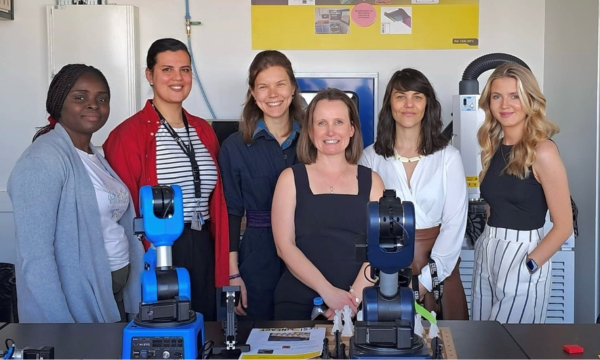In the fast-paced world of business, innovation is the cornerstone of success. However, even the most forward-thinking companies sometimes find that their aspirations exceed their in-house capabilities. With groundbreaking ideas in hand, businesses often discover they lack the specialised expertise required to bring these concepts to fruition.
This gap between ambition and expertise is where the opportunity for collaboration with external partners, such as universities, becomes not only beneficial but essential. Universities represent a vast source of global talent, making them prime candidates for partnerships that can significantly enhance a company’s research and development (R&D) activities.
The Synergy of Academia and Industry
The collaboration between universities and businesses is a powerful relationship that merges the theoretical with the practical. Universities have always had a strong focus on innovation, housing some of the world’s brightest minds and most advanced research facilities. When businesses tap into this knowledge and resource, the potential for breakthroughs in R&D is immense. This partnership is a two-way street; it provides academia with the opportunity to apply theory to real-world scenarios and offer students valuable hands-on experience in their field of study.
Unravelling the Benefits of University Collaboration
Access to State-of-the-Art Facilities: Many small to medium enterprises (SMEs) and even larger corporations may not have immediate access to up-to-date facilities. Universities, on the other hand, often do. Through collaboration, companies can leverage these state-of-the-art resources, which would otherwise be extremely costly, to advance their R&D efforts.
World-Class Expertise: Universities are home to leading experts across a multitude of disciplines. By partnering with these institutions, companies gain access to a pool of talent that’s at the forefront of their fields. This access can be invaluable in navigating complex R&D challenges and incorporating cutting-edge techniques into projects.
Overcoming Obstacles: Innovation is rarely a straightforward path; it is often fraught with technical and conceptual hurdles. Collaboration with universities can provide fresh perspectives and approaches to problem-solving, helping businesses overcome obstacles more efficiently and effectively.
Boosting the Local Economy: University collaborations often have a ripple effect on the local economy. They can lead to the creation of new jobs, attract investment, and foster a culture of innovation within the community. This relationship not only advances the company’s objectives but also contributes to economic growth and development.
Accelerating R&D Projects: Time is of the essence in the competitive landscape of business. University partnerships can accelerate the R&D process, thanks to the readily available expertise and resources. This acceleration can be a crucial factor in achieving a faster time-to-market for new innovations, providing that competitive edge all businesses are searching for.
Aligning Skill Sets with R&D Objectives for Future Success
In the realm of research and development (R&D), the synergy between businesses and universities has never been more crucial. The selection of academic partners with the right expertise and capabilities becomes imperative. The benefits of such collaborations are maximised when there is a commonality between the business’s goals and the university’s strengths.
One of the first steps in forging a productive university-business partnership is identifying academic institutions that have a proven track record in the specific area of your R&D project. Whether it’s biotechnology, engineering, computer science, or any other field, working with universities renowned for their expertise in that domain can significantly enhance the quality and speed of your R&D activities.
Beyond matching skill sets, it’s essential for businesses to partner with universities that share their vision for the future. This means looking for institutions that are not just leaders in their field but are also forward-thinking and adaptable to emerging trends.
Furthermore, collaborations should be structured with an eye on long-term objectives and future goals. Successful collaborations often extend beyond a single project, leading to a lasting relationship that can span multiple R&D initiatives, so having this longevity in mind at the start is important.
R&D Collaboration In Practice
The UK boasts a number of academic institutions renowned for their cutting-edge research and innovation. This network of universities presents a key opportunity for businesses looking to push the boundaries of technology and development. LimestoneGrey’s recent article touched on the amazing support Aberystwyth university provides to businesses. In addition, there are two notable examples that stand out for their distinctive contributions to business innovation: CEMET (Centre of Excellence in Mobile and Emerging Technologies) at the University of South Wales (USW) and CU Innovation at Cardiff University.
CEMET (USW University): Spearheading Innovation with Emerging Technologies
CEMET, based at the University of South Wales, is dedicated to helping businesses in Wales innovate and grow by leveraging mobile and emerging technologies. With a focus on sectors such as software development, virtual and augmented reality, and artificial intelligence, CEMET provides a unique skill set to businesses looking to explore new technological frontiers.
What CEMET Offers:
- Expertise in applying emerging technologies to solve business challenges.
- Support for product development, from concept validation to prototype creation.
- Access to cutting-edge research and technological insights.
CU Innovation (Cardiff University): Facilitating R&D Collaboration with Advanced Facilities
Cardiff University’s CU Innovation is another exemplary initiative that nurtures collaboration between academia and industry. With a robust infrastructure for research and development, CU Innovation serves as a bridge for businesses seeking to enhance their innovation capabilities.
What CU Innovation Offers:
- Advanced facilities and laboratories equipped with the latest technologies.
- A wide range of expertise across disciplines, including engineering, biosciences, and computer science.
- Support for collaborative R&D projects, from initial research to commercialisation.
Matthew Smith, Commercial Manager at CEMET commented:
“Universities can help businesses bridge the gap between ideation and investment/grant opportunities, providing access to the latest cutting-edge technology and innovation that may not be found in the private sector.
“Through programmes such as Knowledge Transfer Partnerships (KTPs), Smart Partnerships, student projects, the USW Exchange Partnership Engagement Programme (PEP) and of course CEMET, businesses can access a wealth of knowledge and adopt new technologies to gain a competitive advantage. Collaboration is key and merging private sector expertise with Academic knowledge of the latest trends in innovation can allow a business to develop, grow and create highly skilled employment opportunities.
“Universities also offer other ways of engagement such as business support events, networking opportunities and access to office space.”
The Role of R&D Tax Credits in Collaborative R&D Partnerships
Matthew Jones, Managing Director at LimestoneGrey, commented:
“The opportunity for business to work with universities on a R&D project opens up so many possibilities, particularly for SMEs. The enhancement a university can make to a research and development project can sometimes be the difference between success and failure. Companies need to be aware that they may still be able to claim R&D tax credits even if they collaborate with an external partner; funds that can be used to kick start a future project.”








